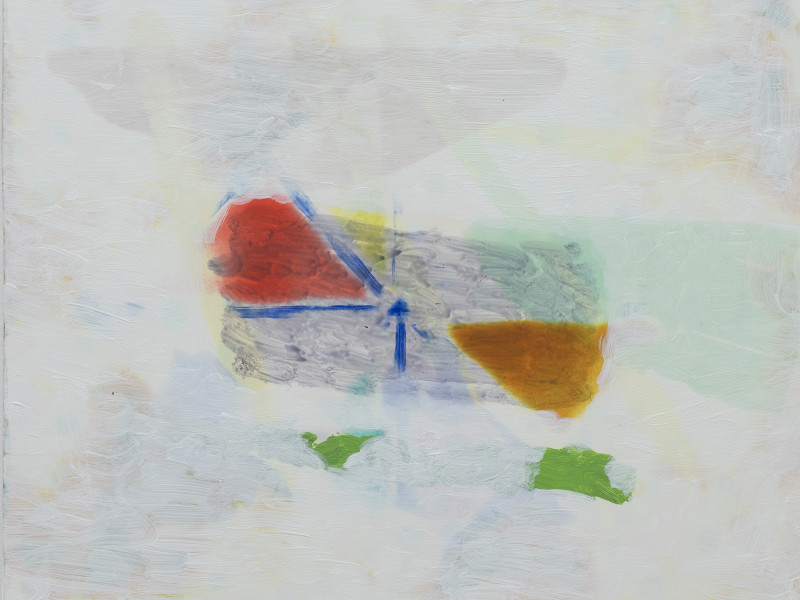Rudi Ninov (Teteven, Bulgaria, 1992) lives and works in Frankfurt, Germany. He began his artistic career by earning a diploma in Art and Design from Tower Hamlets College, London, in 2012. He then pursued a Bachelor’s degree in Fine Arts at the renowned Goldsmiths, University of London, completing the programme in 2015. After several years dedicated to independent work and research, Rudi moved to Frankfurt in 2018 to study painting under Amy Sillman, Monika Baer, and Nikolas Gambaroff at the Städelschule. Since graduating in 2022, he has been living and working in Frankfurt, Germany.
His works have been exhibited in numerous institutions and galleries across Europe and internationally. Recent solo exhibitions include Writing Paintings, Galleria Continua, San Gimignano (2023); Colour Folds, Galleria Ginsberg, Lima, Peru (2022); Colour Words in Prologue, Sarieva / Gallery, Plovdiv (2021). Selected group exhibitions include Dog Days, Structura Gallery, Sofia, Bulgaria (2024); Sensing Painting, Castello Di Rivoli, Fondazione CRC, Italy; Places and Events, König Galerie, Berlin, Germany (2023); Brittle Power, Kunsthal 44Møen, Denmark; Pretty sure it’s just the wind, Goethe Institute and Swimming Pool, Sofia, Bulgaria (2021); ORBIT, Messeturm, Frankfurt am Main (2020); Gravity works only when youlook down, Vaska Emanuilova Gallery, Sofia (2019); FOTEL, Sotheby’s, Frankfurt am Main; EY-Benefizauktion, Museum Angewandte Kunst, Frankfurt am Main, Germany (2019); SCULPTURE NOW, Credo Bonum Gallery, Sofia, Bulgaria (2018); Close Encounters, ICA, Sofia, Bulgaria (2017).
Rudi is also the recipient of the Linklaters LLP Prize, Germany (2020) and CulturalPerspectives Foundation Scholarship, Bulgaria (2019).His works are part of the Museum Voorlinden, Caldic Collection, Wassenaar, TheNetherlands; Fondazione CRC, Cuneo, Italy; Imago Mundi Collection, Treviso, Italy.
-
Rudi Ninov’s practice spans drawing, sculpture, painting, and writing, reflecting a dynamic interplay between two distinct aspects: the formal and the personal, the abstract and the figurative. His work unites bold, sculptural forms with carefully selected colour fields and defined edges, drawing inspiration from a wide range of influences, including music, found objects, comic strips, and visual fragments of fiction and poetry. His paintings function as visual scriptures, meditating on the interplay between spoken and written languages while offering a synesthetic experience that engages multiple senses.
Rudi’s treatment of the painting surface is both surprising and playful, achieved through a complex process of layering and washing away thin layers of paint to create radiant colours, set like gemstones into precise contours. This enables fluid transitions between works, as if each painting slides into the next, forming a continuous dialogue across his practice. Frequently, his paintings are paired as diptychs or integrated into larger compositions—a diagrammatic structure that reflects his ongoing fascination with the cinematic techniques of early 20th-century animation.
His approach is both gestural and tactile, blending intuitive spontaneity with deliberate precision. His work uniquely merges drawing with painting, and painting with form, capturing a sense of immediacy in both material and method.
Rudi’s sculptures, much like his paintings, evolve through a process of intuition and creative exploration, gradually transforming into complex forms that populate his vast visual lexicon. These abstract forms often reach the boundaries of figuration, subtly evoking recognisable elements of plants and other natural life forms while remaining elusive and open to interpretation. At times, his sculptures take on a smaller, utilitarian scale, resembling fictional artefacts - their original purpose obscured by the passage of time, evoking a sense of mystery and otherness. The sculptures seem to find their final shape through the addition of carefully crafted fragments, often suspended from hook-like contraptions on the wall, as if to mark the conclusion of a creative ritual. This interplay of abstraction, function, and imagined history highlights the fluid, exploratory nature of his practice, bridging the personal and the universal in his artistic language.
